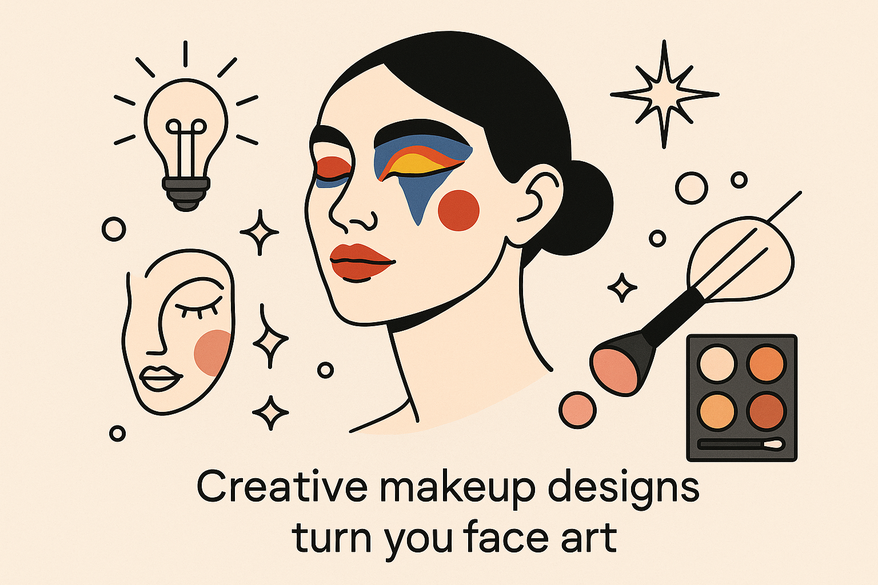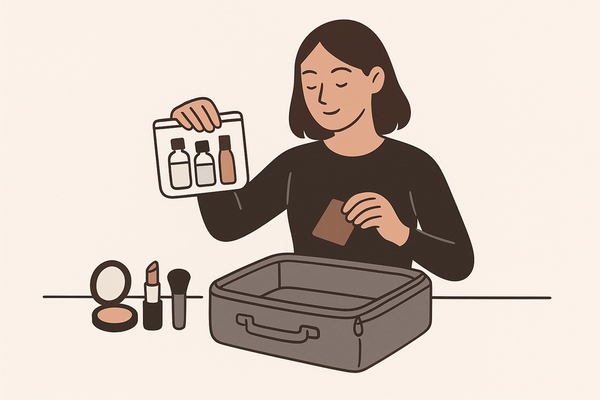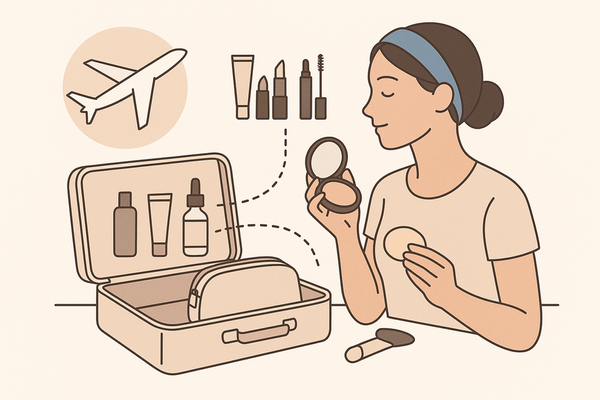Creative Makeup Designs: Transform Your Face into Art
Discover how creative makeup designs turn your face into art with innovative techniques and celebrate individuality. Explore trends and tools today.

Estimated reading time: 10 min read
Key Takeaways
- Creative makeup transforms the face into living art, blending innovation and self-expression.
- Origins span from ancient rituals to digital democratization via social media.
- Key styles include avant-garde, fantasy, theatrical, experimental, and cultural looks.
- Essential techniques: airbrushing, body painting, 3D effects, highlighting, and contouring.
- Future trends feature AR filters, smart pigments, eco-friendly materials, and AI personalization.
Table of Contents
- Historical Context and Evolution of creative makeup designs
- Types of creative makeup designs
- Techniques and Tools for creative makeup designs
- Step-by-Step Guide to Creating a creative makeup designs Look
- Inspirational Sources and Trends in creative makeup designs
- Challenges and Considerations for creative makeup designs
- The Future of creative makeup designs
- Conclusion
Historical Context and Evolution of creative makeup designs
From the pigments of ancient rituals to the avant-garde runways of the 20th century, creative makeup has always mirrored cultural innovation.
Ancient origins
- Early cultures in Egypt, Greece, and India used pigments for rituals, status, and protection.
- Natural dyes like kohl, ochre, and plant extracts created symbolic markings and beauty statements.
20th-century momentum
- Theatrical productions in the 1920s and 1930s popularized exaggerated eye and lip looks.
- Avant-garde fashion shows in the 1960s showcased makeup as performance art (see theatrical study guide).
Pioneering artists
- Serge Lutens: Merged makeup with fine-art sensibilities in Paris salon creations.
- Pat McGrath: Introduced bold textures, metallic finishes, and surreal color combinations on runways.
- Kevyn Aucoin: Blurred lines between portrait painting and makeup, elevating contouring techniques.
Digital democratization
- Social media platforms enable global sharing of makeup art in real time.
- Online tutorials and challenges spread novel effects and inspire cross-cultural fusion (see face art inspiration).
Types of creative makeup designs
Avant-Garde
- Definition: Nontraditional, flamboyant looks emphasizing conceptual innovation over everyday wear.
- Characterized by: Exaggerated shapes, bold lines, and surreal color blocking.
- Visual impact: Shapes that extend beyond eyelids and lips to facial planes (see face art inspiration).
Fantasy
- Definition: Mythical or dreamlike characters built with pigments, prosthetics, and shimmer.
- Tools: Layered glitter, high-pigment paints, and fine contour for otherworldly depth.
- Example: Mermaid transformations with iridescent scales painted across cheeks and forehead (see face art inspiration).
Theatrical
- Definition: Character-driven makeup designed for stage and screen visibility.
- Features: Exaggerated highlights, stark shadows, and color to read under stage lights (see theatrical study guide).
- Example: Aging makeup or creature effects using latex appliances.
Experimental/Abstract
- Definition: Bold or minimalist art using geometric shapes, unexpected color placement, or decorative elements.
- Approach: Asymmetrical lines, vibrant dots, or negative space to create visual intrigue.
- Example: A single neon stripe arcing from temple to cheekbone (see face art inspiration).
Other styles
- Cultural heritage makeup: Incorporates traditional symbols, tribal patterns, or henna-style filigree.
- Glow-in-the-dark/UV makeup: Uses reactive pigments for club events, festivals, and immersive art experiences (see face art inspiration).
Techniques and Tools for creative makeup designs
Airbrushing
- Even, high-definition finish for complex gradients and crisp patterns.
- Ideal for covering large surfaces with minimal texture.
Body painting
- Full-body coverage with water-based or alcohol-activated paints.
- Transforms limbs and torso into extensions of facial art.
3D effects
- Prosthetics, gems, feathers, or textured materials add real dimension.
- Medical-grade adhesives secure pieces for dancing, photo shoots, or performance (see theatrical study guide).
Highlighting and contouring
- Stylized sculpting to enhance or distort facial structure.
- From subtle model-esque shading to dramatic theatrical angles.
Essential tools and products
- Professional brushes and sponges for precision and blending.
- High-pigment eyeshadows, face paints, and liners for vivid color payoff.
- Medical-grade adhesives and prosthetic materials for safe 3D builds.
- Setting sprays, sealants, and powders to lock in multi-layer designs (see theatrical study guide).
Step-by-Step Guide to Creating a creative makeup designs Look
- Conceptualize
• Gather inspiration from fashion, art, nature, or emotion.
• Create a mood board or sketch key elements first (see best inspiration tips). - Prep the skin
• Cleanse thoroughly to remove oils and debris.
• Moisturize and apply primer for smooth application and longevity. - Outline
• Use a nude or white pencil to map major shapes, color-block zones, and guide lines. - Layer color
• Build hues gradually.
• Blend gradients with fluffy brushes; apply bold lines with firm synthetic brushes. - Add details
• Incorporate 3D elements like gems or feathers.
• Use shimmer pigments and fine brushes for texture and highlights. - Set the look
• Finish with setting sprays and translucent powders to prevent smudging.
Pro tips
- Start with simple designs and master each technique separately.
- Embrace mistakes as creative detours—learning happens outside the comfort zone.
Inspirational Sources and Trends in creative makeup designs
Fashion runways and editorials
- Designers’ color palettes and textures spark new makeup concepts.
- Unexpected pairings like metallics with pastels influence art direction.
Fine art and pop culture
- Symbolism from painters and sculptors translates into brushstroke-inspired effects.
- Movie and music video aesthetics drive dramatic thematic designs (see best inspiration tips).
Music and digital influencers
- Viral Euphoria-style glitter tears and bold graphic liners gain millions of views.
- TikTok face-art challenges encourage fresh ideas and community feedback (see face art inspiration).
Cultural festivals and UV events
- Traditional motifs meet glow-reactive paints for immersive experiences.
- Carnival and Holi remind artists of bold color use and celebratory patterns.
Challenges and Considerations for creative makeup designs
Product longevity
- Challenge: Smudging or fading under heat and movement.
- Solution: Use quality primers, layer paints, and finish with sealants.
Skin sensitivity
- Challenge: New pigments or adhesives can irritate skin.
- Solution: Perform patch tests; choose hypoallergenic, fragrance-free formulas.
Execution complexity
- Challenge: Advanced techniques can overwhelm beginners.
- Solution: Break designs into small, focused steps; build foundational skills first (see importance of creativity).
The Future of creative makeup designs
Augmented Reality (AR) filters
Virtual try-ons let artists pre-visualize color placements and effects.
Smart pigments
Mood- or light-reactive colors shift in different environments.
Eco-friendly materials
Plant-based pigments and recyclable packaging reduce waste.
Personalization
AI-driven color matching and bespoke formulations for diverse skin tones.
Stay curious and experiment with new technologies. Pioneer your own creative makeup designs and share them with the world!
Conclusion
Creative makeup designs redefine beauty by treating the face and body as a canvas. From ancient rituals to AR filters, these artistic looks foster originality and celebrate individuality. We covered:
- Definition and importance of creative makeup designs
- Historical evolution and pioneering artists
- Key types: avant-garde, fantasy, theatrical, experimental, and more
- Techniques, tools, and a step-by-step creation guide
- Sources of inspiration, common challenges, and future trends
Tools like Makeup Check AI can also inspire creative designs by generating instant makeup looks and providing personalized artistic suggestions in real time.
FAQ
- What exactly is creative makeup design?
Creative makeup design transforms the face or body into an artistic canvas, using pigments, textures, and tools to tell stories, evoke emotions, or create avant-garde visuals. - How can beginners start experimenting?
Begin with simple color-block shapes, practice contouring fundamentals, and gradually layer in 3D elements like gems or feathers as skills grow. - How do I ensure my makeup lasts?
Use a quality primer, layer products thinly, and seal with setting sprays and powders to lock in multi-layer designs. - Are these techniques safe for sensitive skin?
Always perform patch tests, choose hypoallergenic formulas, and avoid known irritants. Medical-grade adhesives and pigments labeled as safe for sensitive skin are recommended.




